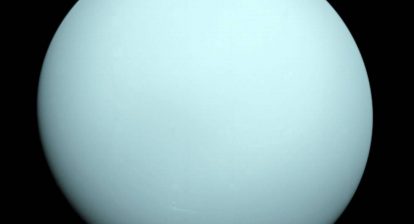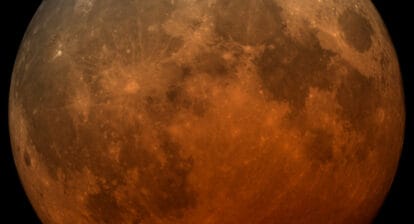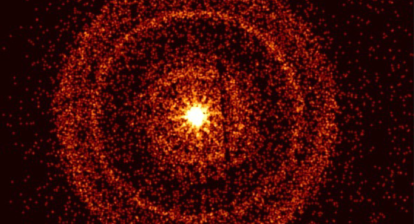Video of New Images of Venus taken by Nasa’s Parker Solar Probe
Blogpost/Transcript
Venus Imaged by Parker Solar Probe
NASA’s Parker Solar Probe has been circling the Sun and taking images of it, and while it goes on with its regular job, it did something else too. It has taken its first visible light images of the surface of Venus from space. According to NASA, “in two recent flybys of the planet, Parker used its Wide-Field Imager, or WISPR, to image the entire nightside in wavelengths of the visible spectrum – the type of light that the human eye can see – and extending into the near-infrared”. The images were captured during its February 2021 flyby and NASA just made the announcement on Feb 9. 2022.
The images, combined into a video, reveal a faint glow from the surface that shows distinctive features like continental regions, plains, and plateaus. A luminescent halo of oxygen in the atmosphere can also be seen surrounding the planet.”
“We’re thrilled with the science insights Parker Solar Probe has provided thus far,” said Nicola Fox, division director for the Heliophysics Division at NASA Headquarters. “Parker continues to outperform our expectations, and we are excited that these novel observations taken during our gravity assist manoeuvre can help advance Venus research in unexpected ways.” The research was published in Geophysical Research Letters.

WISPR and Magellan iamges of Venus on Parker Solar Probes 4thFlyby. Credit: NASA/APL/NRL/Magellan Team/JPL/USGS

As Parker Solar Probe flew by Venus in February 2021, its WISPR instrument captured these images, strung into a video, showing the nightside surface of the planet Credit: NASA/APL/NRL
What Do We Know About Venus?
Venus is known as Earth’s evil twin because while it is similar to Earth’s size and density, it is extremely inhospitable, with intensely hot temperatures. Therefore, such images can help researchers understand the planet’s “surface geology, what minerals might be present there, and the planet’s evolution”. Because of the similarities between Earth and Venus, the information gleaned from the images can help scientists understand why Venus became inhospitable and Earth became an oasis.
“Venus is the third brightest thing in the sky, but until recently we have not had much information on what the surface looked like because our view of it is blocked by a thick atmosphere,” said Brian Wood, lead author on the new study and physicist at the Naval Research Laboratory in Washington, DC. “Now, we finally are seeing the surface in visible wavelengths for the first time from space.”
Venus is the second planet from the Sun, and is our closest neighbour, as well as being one of the four inner terrestrial planets along with Mercury, Earth, and Mars. It is also the third brightest object in the night sky. Venus however has a thick and toxic atmosphere filled with carbon dioxide. This makes it completely shrouded with sulphuric acid clouds that trap heat and create a runaway greenhouse effect. This greenhouse effect makes Venus roughly 700°F (390°C) hotter than it would be without a greenhouse effect, and which makes it the hottest planet in the solar system, even hotter than Mercury, which is closer to the Sun. Its sulphuric acid clouds start at an altitude of 28 to 43 miles (45 to 70 kilometres) and smell like rotten eggs! So, it is unlikely to have life as we know it on its surface, but some scientists think there might be microbes high in the clouds where it is cooler and where the pressure is like that of Earth. Phosphine, which is a possible indicator of microbial life, has been observed in these clouds.
Surface temperatures on Venus are about 900 degrees Fahrenheit (475 degrees Celsius). Such temperatures are hot enough to melt lead. Its surface is of a rust colour, sprinkled with “intensely crunched mountains and thousands of volcanoes,” according to NASA. Scientists think some of those volcanoes might even be active. It has no moons or rings, however, like Earth it does have an iron core, enveloped by a hot-rock mantle and a thin crust. But unlike Earth this internal dynamo does not produce a magnetic field. Although it does not have its own internally generated magnetic field, Venus has an induced magnetic field, created by the interaction of the Sun’s magnetic field and the planet’s outer atmosphere known as the ionosphere. This induced magnetic field envelops the planet and is shaped like an extended teardrop, or the tail of a comet, as the solar wind blows past Venus and outward into the solar system.
Furthermore, its surface pressure is intense as well, at more than 90 times that of Earth. And it rotates backwards on its axis, so that the Sun rises in the west and sets in the east. (Uranus – A Planet Tilted). It also rotates very slowly on its axis, and this results in one day on Venus lasting 243 Earth days. But it orbits the Sun faster than the Earth and one year on Venus takes only about 225 Earth days. This makes a Venusian day longer than its year!
When it is the nearest to Earth, Venus is at a distant of about 38 million miles or about 61 million kilometres. However, most of the time Venus and Earth are farther apart. In fact, Mercury is closer to Earth more often than Venus. Venus has a diameter of 7,520 miles (12,100 kilometres), almost like that of Earth. Its surface is young though – less than a billion years old and perhaps even as young as 150 million years old. This fact has puzzled scientists because they do not yet know why Venus completely resurfaced itself.
Venus is bright and easy to spot in the night sky and is either a morning star or an evening star, when it rises in the east a little while before dawn or sets in the west just after dusk, respectively. It is named after the Roman goddess of love and beauty. Even van Gogh painted it in his famous painting the Starry Night.
Exploration
Even though it is inhospitable, Venus was the very first planet whose surface was reached and subsequently explored by spacecraft from Earth. It was studied intensely early in space exploration history. But due to the intense heat, our landers survived only a few hours on its surface. In 2021, three new missions to Venus have been announced to be launched in the late 2020s, which hopefully will give us a lot more information about our evil twin in space – how it was formed and how it became the hellscape it is today.







